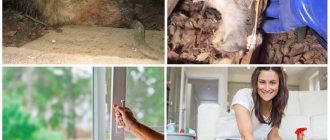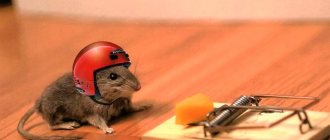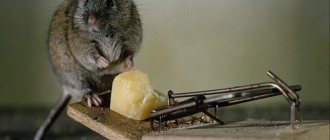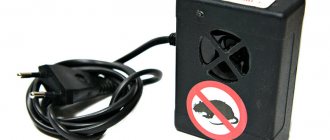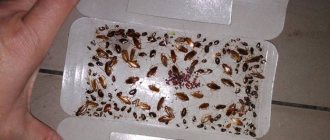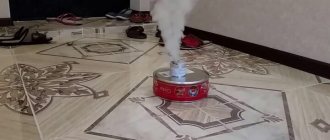Wooden and frame houses are ideal habitats for mice. Here they will always find not only food for themselves, but also enough places to build a nest.
Rodents are able to get into the narrowest crack and climb the walls to the second floor and even into the attic. But what causes the most trouble for owners is mice under the floor in a house or bathhouse. This is exactly the place where they are most difficult to deal with.
Mice under the floor - how to get rid of them?
Animals are nocturnal, and it is at this time that it is easy to spot them living together with you in the same house. If you notice a mouse scratching and squeaking under the floor, get ready for a long and hard fight. If you decide to leave everything as it is, you risk getting an offspring of approximately 60-40 individuals from each female in a year.
Why is underground space attractive to rodents?
The space between the rough board and the floor is usually filled with some kind of insulation - polystyrene foam, mineral wool or glass wool. The mouse is able to gnaw on each of these materials and build another nest from them.
It should be noted that the animal is constantly gnawing on something not because it wants to eat. This is due to its physiological characteristics - the upper incisors of a mouse grow very quickly and are designed to grow in such a way that they need to be sharpened almost every minute. For this reason, the mouse chews everything it comes across on its way. And it doesn’t matter at all what it will be - a crust of bread, a forgotten piece of cheese, polystyrene foam or a roll of wallpaper on the mezzanine.
If a mouse is found under the floor in the house, it will always find that gap through which it will sneak into the kitchen and living rooms. This means that the animal will have constant access to food, which will provide it with a comfortable existence even in winter in a country house. A rodent can feed not only on food in the usual sense of the word, but also on soap, wallpaper paste, cat food, rotted grain, wire braid - in general, anything it can find.
The animal under the floor feels completely safe - a person cannot get there. Therefore, you can safely build nests there and breed offspring.
An even bigger problem is a mouse under the floor in an apartment in a multi-story building. In such a case, we can safely say that almost all neighbors have rodents, and everyone will have to remove the rodents at the same time. The breeding ground is usually the garbage disposal and supplies of sugar, flour and other groceries in apartments.
The mouse has a very good sense of smell; it can smell food two kilometers away. Taking into account the fact that the rodent easily makes its way through the smallest cracks, it will come to where it is better to “feed”. The place under the floor between the concrete and the boards will also be the safest for it. This is where the question arises for the owners of houses and apartments - what to do? I don’t want to remove the floors and it’s expensive.
Signs of large rodents
Signs of a rat
- There is a specific unpleasant odor characteristic of the mouse family.
- Eating food supplies. Rats eat everything a person eats. They can steal meat, lard, cookies, sausage, salad, bread. Any product not hidden in the refrigerator or bread bin.
- Presence of excrement in the form of small black peas.
- Damage to property. Rats' incisors grow daily. To prevent their excessive increase in size, animals are forced to constantly grind their teeth on hard objects. Wooden products, plastic, leather, rubber can be damaged.
- The presence of rustling sounds at night. Rats settle in an apartment under the floor, in the walls, on the ceiling, if there is a layer of insulation there. You can hear the animals gnawing on hard objects, running, and squeaking.
A clear sign that there are rats in the apartment is holes in the wall.
Rodents are able to enter the premises through the sewer through the toilet. You can see an interesting picture in the morning - the protruding face of a rat in the toilet.
Mouse under the floor - what to do?
So, the source of the night noise and squeaking has been discovered, all that remains is to decide how best and most likely to get rid of unwanted guests. The most important question in this case is that the dead mouse does not remain under the floor, otherwise you are guaranteed a special smell of decomposition in the house.
We bring to your attention how to get rid of mice under the floor with the best results.
Mouse traps
The principle of operation of traps is based on the action of the bait that the mouse goes to. At night, the animal gets out of its burrow or from under the floor and follows the smell. The familiar mechanical mousetraps are not always effective; the rodent manages to jump out before the mechanism works. One of the disadvantages of such mousetraps is that the corpses must be thrown away.
Swissinno Super Cat
The peculiarity of the trap is that the manufacturer offers a ready-made bait that combines the five most attractive aromas for mice. Rodents are unable to resist such a tempting smell and try to get the bait.
- gripping tongs kill mice but are completely safe for children and pets
- high sensitivity of the mechanism;
- replaceable baits
- price - from 350 rubles/2 traps
The devices are installed near burrows, crevices and at the location of traffic. The peculiarity of the Swissinno Super Cat is that several animals can get under the mechanism at once. Again, then they will have to be thrown away somewhere.
Electric traps Victor
A new type of trap based on the action of an electric discharge. The device runs on batteries; the charge is enough to destroy several dozen individuals. The main advantage of the device is that a person does not see dead rodents and can throw them out of the storage container without even looking in its direction.
The trap is a closed, neat house consisting of two levels. The mouse, attracted by the smell of the bait, runs up the stairs and ends up on a platform located in the zone of action of the electric discharge. As soon as the sensors are triggered, the animal dies within one or two seconds and automatically ends up in the container.
- The cost of the trap is from 8,000 rubles
The device can kill up to 10 mice in one night. At the same time, you do not hear the sounds of a clicking spring or the squeak of an animal that is not completely killed. Victor traps are in deserved demand among the population and are particularly effective. The devices are also placed along the path of mice or in places where they may appear.
Poison baits
Modern poisonous baits are produced in three types - acting almost instantly, killing after a few days and mummifying. A particular inconvenience of the first two methods is that the mouse can, even with the last of its strength, crawl under the floor and die there. The smell of decay will tell you about the fact of what happened, from which no amount of ventilation will help. Poisons should be used carefully, especially in homes where there are children and pets.
Retail sales and online stores offer baits with a mummifying effect. The body of the animal does not decompose after death, but begins to shrink. Even if the animal dies under the floor or in another hard-to-reach place, there will be no smell.
One of the effective mummifying baits is Valbrenta Chemicals . The kit includes bags with different baits, a house and disposable gloves. The bait house not only attracts mice to look in, but also prevents cats or dogs from getting inside.
- The cost of the set is from 395 rubles
All formulations are treated with boric acid and other substances, which prevents tissue from decomposing. Using the product simultaneously in the house, in the underground, in sheds and in open areas gives an excellent result - the mice die and almost completely disappear.
Ultrasonic repellers
If you want to know the most effective way to deal with mice under the floor , you will have to purchase an ultrasonic repeller. The devices emit waves of different frequencies in the ultrasonic range, which causes discomfort in rodents. They cannot adapt to the chaotic change in frequencies and are forced to look for a more suitable place to live. As a result of the devices' action, there will be no corpses; the animals simply leave your home. You should know that devices should be installed at each level (floor).
Repeller Tornado 400
It has an effective effect on an area of up to 400 square meters . The device is a small plastic box that is installed in an outlet approximately 60-80 centimeters from the floor. In this case, it is necessary to ensure that there are no concrete obstacles or furniture standing in the path of the rays. For greater efficiency, you can connect several repellers in one room.
- A small device, which is a rectangular box measuring 9 by 9.5 centimeters,
- weight - 0.5 kilograms.
- Its power does not exceed 10 W.
- cost - from 2100 rubles
Basic ways to eliminate odor
First of all, to eliminate the smell, you need to remove its source. But even after this, you can feel its remnants due to the fact that it has managed to be absorbed into the surfaces of walls, floors, furniture and textiles. How to get rid of the scent completely?
Vinegar
Vinegar perfectly eliminates mouse odor while disinfecting surfaces. The product is used to treat walls, floors, furniture, and textiles. A solution of 1 part vinegar and 5 parts water is sprayed with a spray bottle.
The pungent smell of vinegar disappears after some time; you can improve the aroma in the room with essential oils, most often lavender, mint or pine are used.
Manganese
Potassium permanganate is a widely used folk remedy for disinfection. Treating all washable surfaces with a sponge and a concentrated solution of potassium permanganate will not only help get rid of unpleasant odors and disinfect objects, but will also repel rodents, preventing their return.
Chlorine
Chlorine-containing preparations will not only help remove the odor, but also disinfect the room. To get rid of odors, use a sponge soaked in the product to treat all washable items. We must not forget that chlorine fumes are toxic, so it is not recommended to use the liquid in an apartment where there are small children or pets.
Hydrogen peroxide
Hydrogen peroxide will remove odor not only from the room, but also from clothes:
- Wet cleaning is carried out with a solution of hydrogen peroxide (800 ml), dishwashing liquid (100 ml), soda (120 g), prepared immediately before treatment.
- The unpleasant smell will be removed from clothes if you soak them before washing for a couple of hours in water with the addition of hydrogen peroxide, the components are taken in a ratio of 6 to 1.
- Surfaces in the room can be treated with hydrogen peroxide using a spray bottle. This measure is applied after cleaning with a chlorine-containing agent to eliminate the remaining pathogens.
Absorbents
Absorbents are good at removing the smell of dead mice. To be effective, they must be placed in close proximity to the source. The vast majority of purchased products in the form of powders, tablets and aerosols only mask the problem rather than eliminate it. Among the available means, good absorbents are salt, lime and soda.
Salt
Salt can be used in living areas to absorb unpleasant odors. It is enough to sprinkle the substance on the source or simply place a fabric bag with absorbent on a shelf. Salt has the ability to absorb moisture and unpleasant odors, and also lightly disinfect the air.
Lime
Lime is used to get rid of odors in non-residential premises. An even, dense layer of absorbent is applied to the site where the rodent dies. The substance eliminates aroma and also destroys bacteria, acting as a kind of filter.
Soda
Soda, like salt, can be used in living rooms. The absorbent absorbs the smell of a dead mouse, in addition, particles of organic tissue. This way the room is disinfected.
Aroma sticks
Incense sticks must be set on fire and carried through all the rooms. The smell is chosen to be pleasant, as it will be absorbed into the wallpaper and will be felt for some time after treatment.
See also
TOP 20 remedies for removing unpleasant odor from a sofa at home
Ozone installations
Ozone is used to clean the room from rats by professional services, for which they use special devices that generate ozone. The ozone unit not only expels rodents, but also eliminates unpleasant odors, and also purifies the air from harmful, toxic substances and impurities.
The big advantage of using ozone is that it does not leave any odors or marks on furniture, clothing, carpets or walls.
Professional products
To disinfect premises and eliminate unpleasant odors, you can use professional sprays, liquids and powders. When working with them, we must not forget about personal protective equipment.
"Lizafin"
"Lizafin" is a potent biocide. The product is concentrated and must be mixed with water before use. Incompatible with soap solutions and synthetic detergents. "Lizafin" is economically used, effectively disinfects surfaces, and does not cause skin irritation when diluted.
"Medifox Des"
The disinfectant liquid has an antimicrobial and cleaning effect. Retains its properties during freezing and subsequent thawing. "Mediafox Dez" kills germs and removes odors.
"Chlorapin"
“Chlorapin” is a chlorine-containing agent used for disinfection, available in the form of powder or tablets. Wipe all surfaces and hard furniture with a rag soaked in a solution of Chlorapin, and after treatment, wash off with water.
Pet Stain & Odor Eliminator
The universal exterminator is designed to combat traces of domestic animals: stains and odors of organic origin. The spray is convenient to apply by spraying the product onto the problem area. You can add liquid to water and wash the floor or wipe other surfaces.
Ventilation
Ventilation is the most affordable way to treat a room against unpleasant odors. A room in which you smell a dead mouse needs to be ventilated. It is advisable to create a draft and leave the room. Fans will help speed up weathering.
Mechanical methods of protection against mice
If for some reason you do not want to use baits, traps or repellers, you can try to protect yourself from mice entering your home in another way. The question will be as follows - how to seal the cracks in the floor from mice.
Swissinno metal wool
It is a strip of stainless material that looks like tangled threads. They can easily seal any, even the smallest cracks, empty spaces in the wall around the pipes. The product replaces the usual mixture of concrete and glass and prevents rodents from getting into the house. The material is safe for people and can be easily removed if necessary.
Can mice climb walls?
To get into a building, rodents use the slightest crack, even if it is high enough above the ground. Mice easily climb walls, using any unevenness and their low weight. They can also enter the house through the attic, especially if the structure is wooden or lined with clapboard. Having climbed inside, they settle in ceilings, in walls, under the floor, going out in search of food at night.
Owners of real estate where these animals have settled describe cases when a rodent, clinging to a curtain or wallpaper, rose to a height of more than 1.5 meters, and from there jumped onto the table where food remained.
These animals also love to live behind drywall. The material doesn’t cost anything to chew through, it’s easy to climb walls made of it, and in most insulation materials, mice make nests for themselves between sheets of drywall.
Protection against rodents during construction
You can try to protect yourself from mice even at the construction stage. It is much easier to prevent a mouse invasion than to deal with them later.
Method 1 - Expanded clay castle
For this, a so-called “pie” is made, consisting of several layers - expanded clay and OSB boards. Such a cake must be at least 10 cm thick and requires the presence of layers:
- A layer of expanded clay of at least 10 cm is laid directly on the ground and covered with a water barrier
- 1 or two layers of OSB-3
- again expanded clay gasket
- finishing layer of OSB treated with boric acid or synthetic wax
Method 1 - Protection with fine mesh
A less labor-intensive, but very reliable method is to use a welded mesh made of galvanized wire with a cell of 5 * 5 mm. It can be laid between the subfloor and the main floor, and also stretched along the foundation strip to a depth of at least a meter. Mice will not be able to get into the house through such a mesh.
Noise and squeaking at night, eaten away insulation in the floor, unpleasant smell? Apparently you have mice infestation. These, at first glance, harmless favorites of Disney cartoons are a real headache for all homes in all countries, for the sake of which new technologies are invented every year, and even new breeds of animals are bred. What are the general methods of dealing with them? And how to secure a bathhouse or country house left unattended? Now we will find out everything.
What materials are not suitable
Since ancient times, people have tried to keep mice out of their homes in a variety of ways. Basically, available and available means were used for this. Progress does not stand still, and relatively new inventions have joined them. But how effective are they?
- Rags, rags. It would seem that the easiest way to plug all the holes and holes. But, at the same time, it is also the most unreliable. Mice will happily chew the fabric into dust and make a hole for themselves.
- Clay, often mixed with sawdust. Not again! Clay is a fairly porous material, easily susceptible to mouse teeth. Sawdust will generally become an additional delicacy.
Clay will not stop mice from entering your home
Silicone. They often fill cracks and holes, but in vain. Mice can deal with this substance, which is quite soft even when frozen, in no time. The same applies to polyurethane foam, with which many people seal cracks. Cured foam will protect you from drafts and even provide sound insulation, but mice will chew it off even faster than silicone. This porous, lightweight material is tough enough for them.
Mice will also work great with silicone and polyurethane foam.
By the way, if you want to prevent mice and their “houses” from appearing in the walls of your house, do not use cotton wool or polystyrene foam for insulation even at the construction stage. Mice will quickly deal with them. It is better to lay the boards directly on the joists as tightly as possible.
What are the dangers of a mouse infestation?
So, let's see what difficulties ordinary house mice can create under the floor:
- Constant noise at night.
- Gnawed cables, wires and pipes made from certain materials.
- Insulation materials turned to dust.
- A specific and not very pleasant “mouse” smell in the house.
- Found mouse waste in the morning wherever possible.
- Danger of contracting rodent-borne diseases.
And also such unpleasant phenomena as a dead mouse under the floor, which is not easy to find and pull out.
Now imagine that in a year a female gives birth to up to 7 mice in each of 10 annual litters. Those. in 12 months there will already be 60-70 new rodents in your house! And each mouse matures within just three months, and also begins to reproduce. At the same time, mice are fast animals: they can reach speeds of up to 12 km/h, jump up to 75 cm in length, and up to 40 cm in height. Just don’t let this problem take its course - they will eat the house too.
Danger of rats
It would seem that the rats live under the floor, and let them continue to live. There is probably no house where these pests would not exist. However, the harm they cause is real, and if this problem is not neutralized in time, the consequences will be dire.
So, rats under floors are dangerous:
- Constant fuss and noise at night . During the day, you most likely will not notice the squeaks and other sounds that rats make, but at night, when the house falls asleep and plunges into silence, constant noises from somewhere below begin to bother you. Because of this, there may be problems with sleep, and if the person is also impressionable, then mental problems;
- Problems in water supply and energy supply . Anything that gets in the way of rats will sooner or later be chewed through. Cables, telephone and Internet wires, fragile pipes of the water supply system are subject to this fate;
- Destruction of insulation . Most of the insulation materials that you decide to use to insulate your walls will most likely turn into either dust or a rat's nest, since its composition is well suited for breeding;
- Excrement . When rats come to the surface, they will leave their waste everywhere, which can become a serious problem during cleaning, as well as for children who can eat it;
- Diseases . Everyone knows that rats carry a terrible number of equally terrible diseases. And the more of them there are in the house, the higher the risk of catching some unpleasant disease. And if rats are starving, they can easily attack a person, which will further increase the risk of illness due to a bite;
- Corpse fumes . If the rat died under the floor, then there is no way to get it out. And her cold corpse will decompose for quite a long time, emitting corpse fumes, which, in addition to an unpleasant odor, can be harmful to health. The situation becomes especially dangerous in summer under the influence of high temperatures. Read about a way to get rid of corpse smell here.
If you find that a rat has chewed holes in the floor, they need to be repaired immediately. This can be done using sheets of metal, after throwing poison and broken glass there. Other rats will come through the newly formed holes in the floorboards, and the more quickly you react, the higher the chance that there will be fewer rats.
Where do mice come from under the floor?
The main goal of mice is food. The secondary goal is to build nests and reproduce in the house where the food is. And mice can smell food two kilometers away! (Note that the bear is only a little larger - for five). That is why, if you leave your country house or bathhouse closed for the season, remove from there everything that could attract these animals.
Frame houses are especially targeted because of their design. Such a house can be built very quickly, quite inexpensively and at the same time fully meets all the requirements. But mice in its walls and floor are a real problem. An invasion of rodents into such a house can begin at the construction stage, but it is difficult to get rid of such pests.
But even the most durable, serious building made of bricks or blocks also rarely manages to avoid the proximity of tailed animals - after all, they love to settle under the floor. And, if the walls can somehow be protected with metal sheets, then it is more difficult to drive a mouse out from under the floor. And with the arrival of cold weather, this beast will find any opportunity to get underground.
Although the mice themselves are different. Thus, in the warm season, voles make their nests in the open air - under boards, near garbage. Until autumn they actively reproduce, and at the first cold weather they go into any enclosed space. Moreover, they can get under your floor even through the slightly open front door and right in front of the owners! But domestic mice don’t really peek out from under the floor at all. Moreover, cats easily get used to the smell.
Features of processing various surfaces
The biggest problem arises when treating porous surfaces, as they tend to absorb odors. This feature is taken into account when disinfecting various materials.
Chipboard
Before processing, the chipboard must be freed from dust and dirt and degreased, and then a disinfectant must be applied on both sides. The final stage is to protect the surface with sealant or polish.
Drywall
If the drywall is soaked through, it is impossible to remove the smell from it. It will be easier to throw away the damaged sheet and replace it with a new one.
Natural wood
The wooden surface is cleaned in several stages:
- First of all, use any absorbent to remove residual liquid; for this purpose, cover the surface with an even, dense layer for some time.
- After removing the absorbent, the affected area is disinfected using folk remedies such as vinegar or potassium permanganate, or professional sprays.
- Finally, the wood is treated with sealant or polish.
Insulation and rodents: is there a solution?
Let's be clear right away - most modern floor insulation materials really don't eat mice, but at the same time they live quietly in them. And they also build nests in soft ones.
Fun fact: Mice's teeth grow throughout their lives. Moreover, if the mouse does not constantly chew something, then these teeth will grow into its upper jaw. Therefore, gnawing is a daily need for this animal. And the mouse can even sharpen concrete walls.
Oddly enough, mice are especially often found in polystyrene foam. Moreover, they gnaw on it - but not with the goal of getting enough, but with the goal of building comfortable nests in it. And therefore, manufacturers recommend insulating walls and floors with ecowool, which is looser and creates an antiseptic environment. But mice also gnaw on it, although not so willingly.
After all, as practice shows, mice can live under the floor in ecowool, foam plastic, and almost any other insulation. Even in glass wool! However, it is worth noting that it is very difficult, almost impossible, for a mouse to chew through ordinary plywood and OSB boards. All because of the structural features of her teeth. Like slabs that have a layered structure with wood chips directed in different directions.
The secret of the survival of these animals in any conditions is their extreme unpretentiousness. That’s why they gnaw holes for themselves in anything, in a word.
Ways of penetration of a rodent into a home
Frame-type private houses are most often attacked by rats. When they are erected, gaps are formed between the joints of the walls and the floor, through which rodents get inside.
The sheathing of walls and roofs has many hollow zones filled with insulation. Rats gnaw out entire tunnels in it, combining them into a whole system of passages: from a cozy nest to a feeding trough.
In a frame house lined with mineral wool, pests gnaw holes directly outside, in any convenient place. Such insulation is unsuitable for further use and must be completely replaced.
It is known that rats are systematic: they move along the same route (along the baseboard, along the walls, near communication pipes) and do not change it unless absolutely necessary. Before you start fighting the pest, you should find out its route of movement.
To do this, you need to sprinkle the floor with flour or starch in the evening before going to bed: in the morning, the paw prints of rodents will be clearly visible on the scattering, from which you can find out their route with an accuracy of a centimeter.
It is necessary to check all the walls of the house or apartments for the presence of passages through which pests entered the room , or penetrate the wall and out. In the vast majority of cases, these holes are construction defects: improperly fixed baseboards, gaps between the floor covering and the wall, cracks at the joints.
In the most secluded and inconspicuous places, the hole can be made by the rats themselves. They easily gnaw through plasterboard wall finishing and almost any insulation, be it mineral wool, ecowool, glass wool, polystyrene foam or expanded polystyrene.
In these passages, pests set up their nest, food storage, as well as organized places for excrement (in such areas there is more rat excrement than the wall insulation itself).
Traditional methods of protecting floors from mice
If you still have mice under the floor, you can also contact a professional service. They carry out a special treatment that allows you to forget about rodents for a whole year. This is the simplest, although not the best option. There are other traditional methods.
Frightening aromas: from mint to burnt wool
When laying the floor, add ash, slag, tobacco dust, dry wormwood or mint to the insulation - mice really don’t like all of this. Some also add red hot pepper or a lot of broken glass.
Moreover, the smell of dried mint has a suffocating effect on the mouse. While you are away from the house, you can even hang this plant in different corners - this really helps.
Protection against rodents during construction
Why at this stage? Yes, because it is much easier to prevent a rodent invasion than to fight them later. And the myths that there are no barriers for mice who want to get into the house are still myths. With a creative and attentive approach to this issue, you can completely ensure that such a misfortune never occurs in your home or bathhouse.
But first, you can carefully study the current building codes, which list grilles, metal screens and other methods of protection. But remember, when installing a metal profile against mice, you must leave a gap so that the insulation does not get wet from condensation.
Method #1 - expanded clay castle
Here we are talking about the so-called “expanded clay castle”, when a layer of expanded clay is laid especially tightly and at least 10 cm thick. Here is a standard floor pie that is protected from mice during the construction of a house:
- 1st layer: lay expanded clay (fired clay) directly on the ground. The layer should be at least 30 cm thick. Cover with plastic wrap.
- 2nd layer: lay OSB-3 boards in two layers.
- 3rd layer: put expanded clay again.
- 4th layer: cover with oriented strand boards impregnated with synthetic wax and boric acid. These substances are good at repelling rodents.
As you can see, nothing complicated.
Method #2 - fine mesh
The simplest and most effective method of mechanical protection against mice even at the construction stage can be called galvanized mesh. It should be made of durable metal and with small cells. Much smaller than you now imagine. Now we will explain why: the mouse’s skull has the ability to “fold”, like that of a newborn, and therefore this animal will really fit where a pencil fits, as biologists like to say.
So, it is advisable to lay the metal mesh over the subfloor during construction and additionally wrap it around the base if you live in a private house. And how to arrange floors with it, you can take a closer look at our photo instructions:
If possible, cover all corners (floor, wall, and ceiling) with mesh, which is usually used for plastering. Don't miss a single connection.
Sometimes this material is used to protect against mice even after construction, when a problem with rodents becomes obvious. To do this, bury it around the foundation to a depth of 80 cm. If you notice already dug holes, then go even deeper. And place a mesh at least a meter high under the plinth sheathing.
What to do if rats have settled behind a plasterboard wall
Drywall is a low-strength and pliable material: rats chew through it without difficulty. In this case, filling holes with cement is completely useless: new moves are made by rats in a matter of minutes.
The only way out is to strengthen the plasterboard slabs with reinforcing fine mesh (cells no more than 8*8 mm). In a private house, the cladding is done from the outside.
The second method is to lay between the plasterboard slabs and the walls materials that are not suitable for arranging a rat’s nest: broken glass, glass wool. Ecowool may also be suitable - this material contains orthoboric acid, a substance that provokes thirst in rats (when they are very thirsty, they leave their “home” place).
For preventive purposes, during the construction of a building or during the renovation process, boric acid powder can be poured between the wall and the insulation to repel pests.
Why are mice dangerous in an apartment?
The main troubles they cause to humans:
- spoiled food;
- wiring faults;
- destruction of house structures;
- water infection;
- danger of short circuit and fire;
- spread of fleas carried by mice;
- spread of infections: typhoid fever, plague, salmonellosis, rabies, cholera, toxoplasmosis. Moreover, the animals themselves, exposed to viruses, were able to develop lasting immunity against many of them. Other viruses are only carried by mice and then reach humans.
On a note. In apartments and houses, domesticated rodents reproduce year-round, unlike their wild counterparts. Moreover, from each female, from 3 to 10 mice can be born every three weeks.
A dead mouse under the floor or between ceilings spreads a stench, and a poisoned mouse that is eaten by a pet can cause illness or even death. In a word, if there are mice in the apartment, nothing good can come from it. There is an urgent need to take measures to eliminate them.
Symptoms of mice in an apartment
- A small hole between the floor and the wall, near the baseboard.
- Traces in the form of droppings.
- “Mouse smell”, quite specific.
- Monotonous rustling: under the floor covering, behind the wall or above the ceiling.
- A cat's alertness if she lives in an apartment: constant sniffing of secluded corners, inspection of the apartment, cautious behavior, as if listening to something.
The problem of fighting mice is so serious that it is dealt with by sanitary services, utility companies, and special companies providing deratization services. But how often do we go there? Excessive red tape, changes in the usual rhythm of life, and fears for the health of pets are stressful. When deciding how to get rid of mice in an apartment, you need to evaluate all known methods and then make a decision. After all, each of them is characterized by both efficiency and non-delivery.
Mice and drywall
Often mice settle behind drywall, and getting rid of these residents becomes problematic. The building material is too thin, pliable and it is easy for rodents to chew through it, no matter how carefully the cracks and holes are sealed.
Builders also advise laying various materials that are dangerous or unattractive to mice in the space between the drywall and the main wall:
Instead of poisonous plants, you can add a layer of boronic acid: again, this is added during the repair process, because after that it will be difficult to do so.
If the pests do settle down behind the drywall, they work according to the scheme described above: they lure them out, destroy them, and close up the holes.
Cat and mouse
Environmentally safe, reliable, not requiring special costs - a live “nurse” - a domestic cat or female cat. It is believed that the cat is most responsible for catching mice. And if it is also three-colored, then getting rid of pests is guaranteed in the shortest possible time. No one has reliably confirmed the theory of tricolor, but no one has refuted it either.
Biological method of rodent control
Attention! If a cat catches mice, you should not simultaneously use chemical methods of destruction. A mouse that eats poison will not die immediately, but will become lethargic, which means it will be easy, but also dangerous, prey for a cat.
Methods for exterminating rats that have settled in the wall
You need to start fighting pests that have settled in the walls by carefully sealing all the holes through which they penetrate inside . The optimal solution is to fill them with concrete mortar mixed with broken glass.
Communications: ventilation, water supply, sewerage - this is another way for rats to enter the space between the walls. They must be covered with a fine-mesh strong metal mesh (a plastic one will be useless here).
The space around communication pipes and cracks must be carefully closed. Special metal wool from SWISSINNO (Switzerland) is suitable for these purposes.
Killing rats using poison can be called a classic method. However, it has the greatest number of side effects:
Poisons with mummifying effect
You can avoid the smell of decomposition from rats that died in “clogged” areas by using special poisons with a mummifying effect. The substances in their composition prevent the decomposition processes of dead rats.
Popular products with mummifying effect:
Intimidation method
To prevent mice from appearing in the apartment or leaving it, repellers are actively used: ultrasonic, electromagnetic or combined. It all depends on the method of influencing animals. In the first case, sounds are generated at frequencies that are beyond the sensitivity of the human ear, but are irritating to mice. In the second, the emitter generates electromagnetic waves that irritate the nervous system. A combination device combines these two methods. In all cases, panic and irritation are sown, and the mice leave the “restless” place. The product is safe for both rodents and humans, as well as pets. “Spectrum” is in particular demand: its coverage area is 300 sq. m., it is not afraid of high humidity and voltage surges in the network.
Poison Attack
If conditions permit, mice in an apartment can simply be poisoned
The most merciless, but also effective way is to poison. It could be "Rat Death" in bags. Special flavoring additives promote its active absorption. Other poisons act on the same basis. Destruction of internal organs also occurs with the help of baits that do not contain toxic substances, but which contain components that have a detrimental effect on the animal’s body. A powder mixture of gypsum and flour (1:1), which gets into the esophagus and is washed down with water, leads to the death of animals. Another remedy is prepared using the same scheme:
- plaster – 2 parts;
- flour – 3 parts;
- sugar – 5 parts.
After adding water, prepare a plate-like mixture from the ingredients and spread it out as bait.
Mice under the floor: how to fight?
The “underground” life of rodents is the most secretive. This is where it is most difficult to get them out. The slightest gap in the floor with the front door open will become a “portal” for the animal to move from the street to the floor. A hectic life takes place there: eating insulation, breeding offspring in warmth and satiety. The methods of struggle are similar. This is due to the fact that mice come out of hiding in search of food and can be exposed to any type of influence. In addition, when covering the floor, you can put ash, tobacco or shag dust, crushed dry mint and wormwood into the insulation. Hot pepper and broken glass in the underground are also effective in fighting rats on the first floor.
Mice love to live under floor coverings
Fight for life
At home, they use modern glue-based traps, poisonous bait, and prepare their own poison for rats.
Traps
Fighting rats with glue traps is very popular. Especially if the apartment is uninhabited. The product is made in the form of glue and is sold in a tube. Does not dry out for 2 weeks, firmly fixes the animal’s paws at the first touch.
- The glue is applied to plywood, oilcloth, or a piece of plastic and firmly fixed to the floor. To catch rats, you need a piece with an area of 50*50 cm.
- Distribute the glue in a continuous line at a distance of 5 cm.
- The bait is placed in the center. The rat hears the smell of food, makes its way to it, and sticks its paws to the rodent glue. The more he tries to get out of the trap, the more he ends up in it.
The advantage of a trap is that several individuals can be caught at once. Disadvantage: animals die a painful death of starvation, making terrible sounds. It will not be possible to rid yourself of an unpleasant sight. The caught rodents are thrown together with the trap into trash cans.
Expelling rats with folk remedies
DIY poison
The extermination of rats is carried out using poison that is safe for humans and pets. Leave treats along the walls overnight.
- Mix flour and gypsum in equal proportions. Place a saucer of water nearby. In the stomach, the product hardens along with the insides. Death is inevitable. You have the opportunity to gradually, safely for yourself, poison the rodents within a month.
- The wine cork is crushed and fried in lard. Treats are laid out. In the esophagus, cork powder swells, causing deformation of internal organs and death. An effective method that allows you to destroy pests in a few weeks.
- Sugar and baking soda are added to the flour. The product causes increased gas formation. Rats are unable to burp, so something as harmless as baking soda can be deadly to them. Can poison you in one go.
Rats are partial to alcohol. They soak a piece of bread in beer and feed it to the rodents. This is done every day, increasing the strength of alcoholic beverages over time. After 2 weeks, the rats are no longer interested in anything other than alcohol. The population is degrading. Cubs are born weak or dead, adults die from alcoholism.
Professional products
In a five-story building, rats can spread throughout the entire house within a few months. Pregnancy in rodents lasts about 24 days, with each litter containing 9-10 babies. Rats grow quickly and become sexually mature adults. Specialists are required to poison rats in an apartment building. If government agencies do not respond, it is necessary to take the initiative into our own hands and involve private firms. In Moscow, the cost of deratization is about 4 thousand rubles. You can contact any service.
The appearance of rats on the second floor indicates the mass reproduction of these animals in the basements. With your own efforts you will be able to protect your apartment from pest invasion, but you will not be able to eliminate the problem completely.
In the apartment it is allowed to use poison in the form of briquettes or processed grain. It is not recommended to use a strong instant-acting poison - Krysid.
Rat Death and Storm are especially popular. The products are prepared in the form of a test mass. Meat flavorings and flavoring additives are added. Having tried the treat once, the animal dooms itself to certain death. To kill a large rat, 1.5 g of poison is enough. Death occurs within 3 days. Mass death of rodents is observed after 2 weeks. You can completely eradicate a colony in a month.
Intrusion Prevention
Lower apartments can be attacked by mice from basements and garbage disposals. What to do in this case? Having discovered rodents, you need to urgently inspect the apartment. Seal all cracks in the floor, between ceilings, walls and baseboards by adding broken glass to the solution. Remove trash near the yard and in the entrance. Put fine mesh nets on the windows. Repair cracked door frames and poorly hung doors. Store food (the stuff that allows mice to enter apartments) in glass containers or in the refrigerator. Place branches of wormwood, peppermint, eucalyptus, lavender, etc. on kitchen cabinets.
If the mice still haven’t left after all the attempts to remove them, you will have to ask for help from the pest control response teams. With their help, although it is not possible to eliminate rodents forever, it is quite possible to ensure a year, or even two, of a quiet life.
